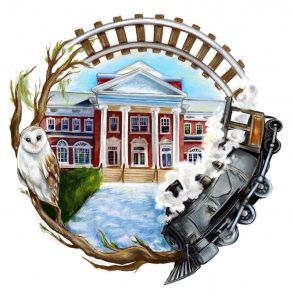In 1927, 14 former railway conductors stepped off a Central of Georgia Railway car and into The Hostess City. The newcomers — all 25-year veterans of the international Order of Railway Conductors — arrived in Georgia to enjoy peaceful retirement, a healthfully temperate climate and a luxurious new home.
The residence, handsomely Georgian in style and modeled after Southern hotels favored by the East Coast elite, was a vast change from the Order’s previous retirement home in Highland Park, Illinois. As the conductors crossed a new bridge from Tybee Road and followed a freshly-cleared drive encompassed in swaying palms, bowing pines and untamed beauty, they became the first official residents of Oatland Island.
Today, Oatland is known for its educational wildlife center, but the island’s history is just as wild.
In the 18th century, the property, then only accessible by boat, was owned by the McQueens, a wealthy family who owned a considerable amount of Southern land. When their patriarch fled to Spanish-owned Florida to dodge debtors’ prison, his son cleared Oatland of its original trees and planted cotton, living in nearby Thunderbolt while he managed the land to support his family. (For more on the McQueen saga, see Eugenia Price’s 1974 historical novel “Don Juan McQueen.”)
In its next life, Oatland gave train conductors, their wives and widows the opportunity to enjoy comfortable coastal retirement. The building, featuring 67 bedrooms and 36 baths, was constructed by Savannah architects Wallin and Comer to the tune of $350,000 (over $5 million by today’s standards). Brass lighting fixtures hanging from a beamed ceiling illuminated the ivory-painted lobby, and a stately white and walnut staircase led conductors to their living quarters.
Residents enjoyed a glass-enclosed porch, billiards in the game room or curling up in front of the lounge’s fireplace, made of stone and granite from each state of the union. In the north wing of the building, conductors took their meals in a stately dining room fitted with elegant draperies and French doors. Dinner was cooked in an all-electric kitchen with an icebox, coffee urns and other modern wares.
Upstairs, each bedroom was furnished with a bed, dresser, phone, telephone table, rug, radiator and chair. The second floor also included hospital facilities, offering convenient care to the retirees, many of whom were veterans with special medical needs.
Oatland remained a serene retreat for retirees until 1941, when occupancy dwindled, leading to its closure and sale to the United States Public Health Service. The Home served as a research hospital for infirm women and children until Malaria Control in War Areas (MCWA) moved in, determined to treat World War II soldiers who were coming home with malaria. In 1946, the MCWA became the Communicable Disease Center, and scientists studied various methods of mosquito control, including the use of DDT as a pesticide, at Oatland. An early version of the modern flea collar was even invented in the former Conductor’s Home.
In 1973, Oatland Island was declared government surplus. Several bids were filed (including one to turn Oatland into a state penitentiary), but one application stood out.
Tony Cope, a Savannah-based teacher and administrator, and a team of collaborators had been looking for an area to transform into an environmental education center. When Oatland was declared surplus, Cope and Fred Schlien, director of Savannah-Chatham County Public School System’s S-teri (Student-Teacher Environmental Investigations) program, surveyed the island and found their dream site.
For a year, Cope traveled with board members to Atlanta and Washington to lobby for their bid. Jimmy Carter, governor at the time, and Sen. Sam Nunn were standout supporters. In August of 1974, the property officially became Oatland Island Wildlife Center.
Now open to the public seven days a week, the Center welcomes around 25,000 students and 60,000 visitors from around the world annually to learn about native flora and fauna, get hands-on science lessons and experience the thrill of nature up close and personal.
In July 2018, a tornado caused extensive damage to Oatland’s cabins and deer, bobcat and wolf enclosures. As of our print deadline, Oatland remains temporarily closed. To become a Friend of Oatland and help recovery efforts, visit www.friendsofoatland.org.

